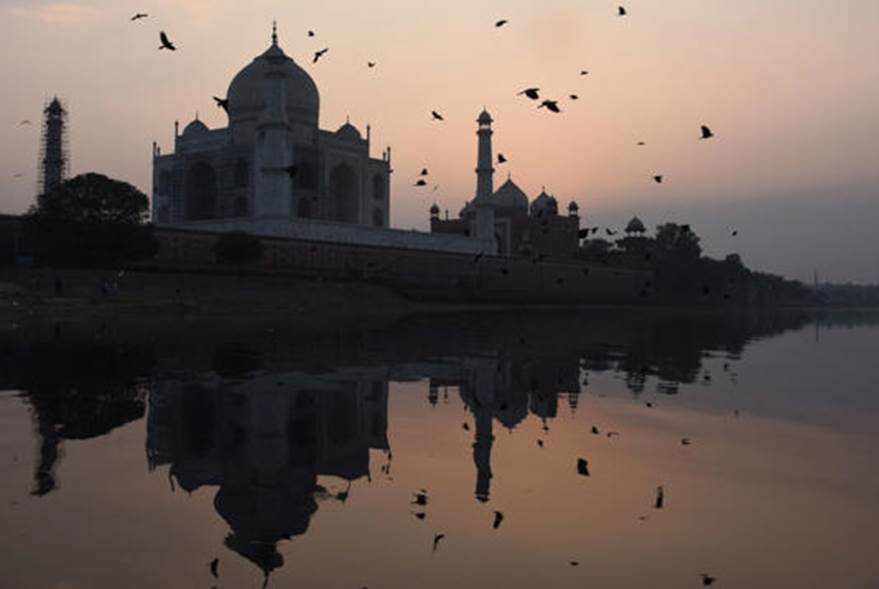
“The minds of children are now under direct onslaught in this kind of intense way, where textbooks must not ever reflect South Asia’s dynamic, complex history,” said Utathya Chattopadhyaya, a history professor at the University of California at Santa Barbara. “So, you basically create a body of students who come out knowing very little about the history of social justice, the history of democracy, the history of diversity, and so on”
New Indian Textbooks Purged of Nation’s Muslim History
By Anumita Kaur

The Taj Mahal is one of India’s most iconic sites. But this year, millions of students across India won’t delve into the Mughal Empire that constructed it.
Instead, Indian students have new textbooks that have been purged of details on the nation’s Muslim history, its caste discrimination and more, in what critics say warps the country’s rich history in an attempt to further Prime Minister Narendra Modi’s Hindu nationalist agenda.
The cuts, first reported by the Indian Express , are wide-ranging. Chapters on the country’s historic Islamic rulers are either slimmed down or gone; an entire chapter in the 12th-grade history textbook, “Kings and Chronicles: The Mughal Courts" was deleted. The textbooks omit references to the 2002 riots in the Indian state of Gujarat , where hundreds of Indian-Muslims were killed while Modi was the state’s leader. Details on India’s caste system, caste discrimination and minority communities are missing.
Passages that connected Hindu extremism to independence leader Mohandas K. Gandhi’s assassination were pruned as well, such as the 12th grade political science textbook line : Gandhi’s “steadfast pursuit of Hindu-Muslim unity provoked Hindu extremists so much that they made several attempts to assassinate [him].”
The new curriculum, developed by India’s National Council of Educational Research and Training, has been in the works since last year and will serve thousands of classrooms in at least 20 states across the country. It follows long-standing efforts by Modi and his Bharatiya Janata Party (BJP) to craft a Hindu nationalist narrative for the country — a platform that Modi ran on in 2014 and secured reelection with in 2019.
“The minds of children are now under direct onslaught in this kind of intense way, where textbooks must not ever reflect South Asia’s dynamic, complex history,” said Utathya Chattopadhyaya, a history professor at the University of California at Santa Barbara. “So, you basically create a body of students who come out knowing very little about the history of social justice, the history of democracy, the history of diversity, and so on.”
India has been home to Hindu, Muslim and many other religious communities for centuries. British rule stoked tensions among communities, leading to violence in 1947 after the country was partitioned into Pakistan and modern India.
Hindu nationalism has intensified under Modi. It has led to violent clashes , bulldozing of Indian-Muslim communities and deepening polarization throughout India and its global diaspora.
The curriculum change is another step in the trend, Chattopadhyaya argued. BJP-led state governments have launched textbook revisions for years. But now it’s stretched to the national level.
“This is actually an intensification of something that’s been happening. It is a way of ‘Hindu-izing’ South Asian history and ignoring all other kinds of diverse plural histories that have existed,” he said.
The director of the National Council of Educational Research and Training, Dinesh Prasad Saklani, declined to respond to The Washington Post’s inquiry on the textbook changes. In interviews with Indian media, he said the revisions were examined by “expert committees” and are meant to ease the workload on students. The committees “recommended that if this chapter is dropped, it won’t affect the knowledge of the children and an unnecessary burden can be removed,” Saklani said.
“Due to COVID, content load has to be reduced,” he told another news outlet . Saklani denied BJP involvement in the decision. He was appointed to lead the government council in February 2022 for a five-year term.
BJP leaders are applauding the move, tweeting that it was “a great decision,” and referring to the prior content on India’s Mughal Empire as a “false history.”
Chattopadhyaya said he believes the changes are alarming, and remove crucial context for students’ worldview.
“So, students will know of the Taj Mahal — like they’ll see photos of it, or they’ll visit it. But in a textbook, they won’t know the social or political or historical details about the time that the Taj Mahal was built in,” he said.
The entire affair is also reminiscent of ongoing contention around teaching about race in schools in the United States.
“At the heart of the pattern is a fear that history-learning by students will produce rational or progressive citizens,” Chattopadhyaya said. “Both the US and India have pretty complex, very challenging histories. The job as a historian or history teacher is to convey the complexity and the challenges to the student, and I think the right in the US. and the right in India do not want critical-thinking, rational-thinking, progressive students, because that is not something they think is valuable to a right wing agenda.”
Meanwhile, memes ridiculing the move took off on social media, leaning into what many viewed as the absurdity of removing key pillars of the country’s history. Instagram account mad.mughal.memes shared a mock-up newspaper featuring a front-page article headlined, “Emperors disappear from paintings in bizarre phenomenon, painters confused.”
Another post depicts a typical Mughal-era scene — wise-looking men atop an ornate carpet — with one Mughal man letting those around him know: “So, kids...looks like y’all are fictional characters now.”
One twitter user answered the all-important question : Who will India credit for building the Taj Mahal? Aliens. - The Washington Post

